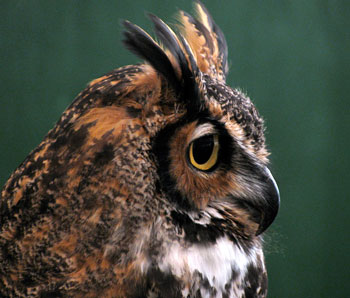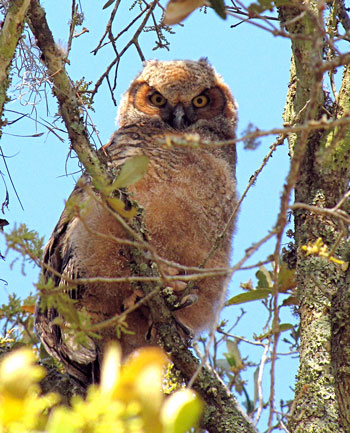By Mary Parker Sonis
The great horned owl has a well-earned reputation as one of the most formidable predators in the forest. I had never actually seen one in real life until I did some exploring in our local Bolin Creek forest. One afternoon, I was sitting on a downed tree simply looking at the woods when I noticed a silhouette in a distant pine that looked like an owl. I thought I was looking at an odd clump of dead branches until I saw the feather tufts that give the owl its name.

The size of the owl was astonishing. An average great horned owl weighs more than 3 pounds and has a body length of about 22 inches and a wingspan in the range of 49 to 60 inches. When the owl took flight, I was taken aback by the sheer enormity of this bird. The wing beats were steady with very little glide, but the flight was strong.
After this initial encounter, I became obsessed with locating this bird at any opportunity. At the time, I did not realize that a pair of great horned owls was nesting in the vicinity of my house. Every day, I returned to the downed tree and took up my post to locate the owl. Day after day, I would search the treetops until I saw that iconic outline, and long before I located him he was staring at me. Even at a distance, the bright-yellow irises of his large eyes were visible. He stared down at me from a series of favored treetops, and I stared back hoping to get a clear view of this magnificent bird.
One day, I had almost given up trying to locate the owl when I had the disturbing feeling of being watched. It was an uneasiness that I cannot fully describe. I looked straight up, and the great horned owl was staring down directly at me. This was the stare of a predator. The eyes of the owl are almost as large as human eyes, taking up about 50 percent of the skull cavity. A bony ring surrounds the owl’s eyes, fixing them in one place, so the owl must turn its entire head in order to look at something. The neck of the owl has extra vertebrae that enable it to turn its head an amazing 270 degrees.
Although the vision of the owl is superb, with excellent night capability, its hearing is even more acute. Locating prey is primarily accomplished by triangulation. The ears are small openings in the side of the head that are offset. By turning and angling its head until the sound is equal, an owl can precisely locate prey both vertically and horizontally.
The owl has powerful talons for hunting and regularly attacks animals that are far larger than itself, eating any animal that it can subdue. Hunting solely by night, this owl will attack and kill in complete silence. The flight feathers of any owl are softly serrated to dampen sound completely. In Bolin Creek forest, the great horned owl preys on raccoons, rabbits, skunks, mice, voles, shrews, squirrels, birds (including barred owls and hawks) snakes, young beavers and muskrats. It is quite capable of killing grown cats and small dogs. In northern regions, the great horned will often take porcupines as prey.
What I found most astonishing was the reaction of the other wildlife to the great horned owl; the forest is changed by its presence. Crows in particular hate the great horned owl, and most times I have gone in search of the owl I have been led to the location by the presence of the mobbing crows. When the crows mob an owl, they are relentless. The calls are deep and rasping. They pursue the great horned from tree to tree, calling and challenging until the owl leaves their territory. On days when the crows are not present, the small birds of the forest rise up in unison to call out the warning. The trees hum with tiny sounds of dozens of wrens, titmice and chickadees as they sound out the alarm.

The great horned is far more reluctant to remain in the presence of humans than the garrulous barred owl, but the results of the great horned owls’ encounters with humans are far more dangerous for the people involved. While the barred owl will often swoop down on unsuspecting hikers and produce scratches on a few heads, the great horned generally reserves its attacks to individuals who come too close to its nest. This rarely happens, unless a naturalist is attempting to examine a nest by climbing high into the canopy. The blows are so formidable that most scientists studying these owls at their nest sites will wear protective helmets with face visors. We are certainly in no danger of attack as ordinary bird watchers, but those scientists who have been hit by a great horned describe the blows as ferocious.
Aside from all these dire warnings, the sighting of a great horned is truly thrilling. It is a beautiful bird with elegant brown and rust markings that serve as perfect camouflage in the trees. They have a tidy white bib on their chest, brilliant-yellow eyes and a fine circle of black outlining the facial disc. The feather tufts on the top of the head will clearly identify this owl.
Because this owl roosts quietly during the day, high up in the canopy, sightings are rare. The low, five-note call is generally heard only at night, with a pattern that sounds like “hoo hoo hoooo hoo-hoo.†In the fall, the mating season begins and you can sometimes hear a pair of owls calling to one another in the woods. Young owls have a dreadfully disturbing call that sounds like a bird being strangled. It is loud and designed to get some attention. Intruder calls are rather hair-raising shrieks. If you hear a great horned in your neighborhood, it might be worth a walk in the woods at sunset, when they become more active.
Every time I encounter the “flying tiger,†my heart beats a little faster.
Categories